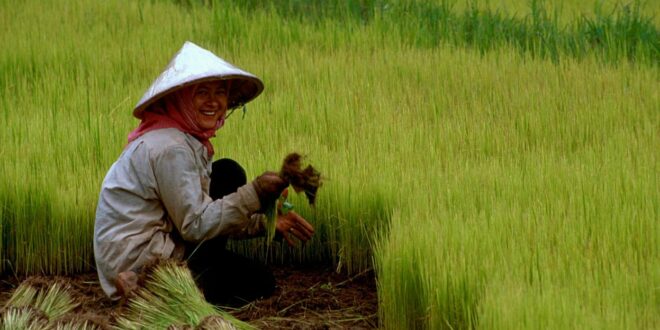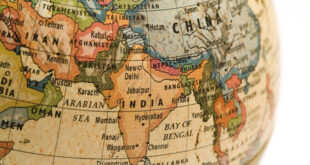Rice stockpiles are poised to reach the biggest in almost a decade as record harvests boost supplies and imports decline for the first time in three years.
Inventories may gain 3 percent to 100.1 million metric tons, the most since 2003, as global imports contract 7.5 percent, the U.S. Department of Agriculture says.
The Thai export price, a global benchmark, may tumble as much as 11 percent to $500 a ton in the first half, the lowest since June last year, the median of 11 trader and exporter estimates compiled by Bloomberg shows.
Rice slumped 15 percent from a three-year high in November as India, the second-biggest grower after China, lifted a three- year ban on exports of non-basmati grain and Thailand, the largest shipper, bought less than expected in the first four months of a government stockpiling program. That’s boosted supplies of the staple for half the world at a time when farmers are planting record wheat and corn crops. Global food costs dropped 10 percent from a record in February 2011, according to the United Nations.
“Indian exports created havoc in the earlier supply-and- demand calculations,” said Jac Luyendijk, the chief executive officer at Preverenges, Switzerland-based SAT Swiss Agri Trading SA, who has worked in the rice industry for about two decades, including stints at Andre & Cie. and Nidera. “We have a very negative outlook.”
Chinese Farmers
The price of 100 percent grade-B Thai rice fell 3.4 percent to $563 this year, as rough rice futures traded in Chicago dropped 3.2 percent to $14.385 per 100 pounds. The Standard & Poor’s GSCI Agriculture Index of eight commodities including wheat and corn gained 0.3 percent. The MSCI All-Country World Index of equities rose 10 percent and Treasuries lost 0.5 percent, a Bank of America Corp. index shows.
Production will advance 2.6 percent to 462.75 million tons this year as imports worldwide drop to 30.12 million tons, the USDA estimates. India may ship 6.5 million tons, the most since at least 1960, as the harvest climbs 6.3 percent to a record 102 million tons, the data show. Farmers in China will reap 2.6 percent more, a record 140.5 million tons.
The expansion is contributing to record supplies of cereals this year as farmers respond to prices that more than doubled since 2005, according to the UN’s Food & Agriculture Organization in Rome. Inflation worldwide may slow to 2.6 percent this year from 3.6 percent in 2011, according to economists surveyed by Bloomberg.
Indian Weather
Global rice prices may be vulnerable to poor growing conditions in exporting countries because only about 7 percent of global output is traded internationally and 59 percent of all cargoes are shipped by three countries, Thailand, Vietnam and India. The 7 percent compares with about 37 percent for soybeans, 20 percent for wheat and 11 percent for corn, USDA data show.
Any change from normal weather patterns in India may spur the government to ban exports once more, said Concepcion Calpe, a senior FAO economist and secretary of the organization’s intergovernmental group on rice.
The Thai government decided last month to extend its program to buy the grain above market rates after purchasing as much as 60 percent less than its target since October, said the Commerce Ministry. The exporters’ association says that may help cut shipments now estimated by the government at 9.5 million tons this year compared with 10.6 million tons in 2011.
Producers Association
Farmers in the U.S., the fifth-largest exporter, may switch fields to more profitable crops, the Houston-based U.S. Rice Producers Association said in a Jan. 13 report. Domestic stockpiles are set to drop to a two-year low before the next harvest after acreage fell to the smallest in more than two decades, the USDA estimates.
“I see farmers reducing their rice acres,” said Dwight Roberts, president of the association. “Soybeans and corn just pencil in better that rice. Crunch the numbers and rice is just not attractive.”
Stockpiles in the five biggest exporting nations will reach a record 31.9 million tons in 2011-2012, the London-based International Grains Council estimates.
The Philippines, formerly the world’s biggest buyer, will cut imports to 500,000 tons this year and to 100,000 tons in 2013 from 2.6 million tons in 2008-2009 when prices rallied to a record as some countries curbed shipments, according to forecasts from the agriculture ministry.
Myanmar, Vietnam
Exports from Myanmar may more than double to 1.5 million tons this year as planting expands, and increase to 3 million tons by 2015, the Myanmar Rice Industry Association said last month. The gain would make the country the sixth-largest shipper, with volumes at the highest level since the 1960s, when it was the biggest exporter.
Shipments from Vietnam, which totaled 7.1 million tons in 2011, may be as much as 7.34 million tons this year, according an agriculture ministry report on its website Feb. 3.
Nigeria, the largest importer, South Africa and Senegal advanced some of this year’s planned purchases to the last quarter of 2011 on concern that prices would rise, said Rakesh Singh, a trader at New Delhi-based Emmsons International Ltd. That means stockpiles are already replenished, curbing demand, said Singh, who’s traded the grain for two decades.
India will continue to export non-basmati rice because stockpiles are still big enough to meet domestic demand, Food Minister K.V. Thomas said Jan. 17, according to a report by the Press Trust of India.
“India’s lifting of the export ban last year reversed the price direction,” according to Chookiat Ophaswongse, the honorary president of the Bangkok-based Thai Rice Exporters Association, which sets the weekly benchmark price. “India’s presence continues to pressure global prices.”
Source: Bloomberg
 Asia Finance News Asia finance news, banking, market analysis, business, Forex, trade, Cryptocurrency as it is happening in Asia. Trusted gateway for Asian financial news.
Asia Finance News Asia finance news, banking, market analysis, business, Forex, trade, Cryptocurrency as it is happening in Asia. Trusted gateway for Asian financial news.





